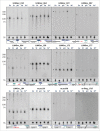Transcriptome landscape of Lactococcus lactis reveals many novel RNAs including a small regulatory RNA involved in carbon uptake and metabolism
- PMID: 26950529
- PMCID: PMC4829306
- DOI: 10.1080/15476286.2016.1146855
Transcriptome landscape of Lactococcus lactis reveals many novel RNAs including a small regulatory RNA involved in carbon uptake and metabolism
Abstract
RNA sequencing has revolutionized genome-wide transcriptome analyses, and the identification of non-coding regulatory RNAs in bacteria has thus increased concurrently. Here we reveal the transcriptome map of the lactic acid bacterial paradigm Lactococcus lactis MG1363 by employing differential RNA sequencing (dRNA-seq) and a combination of manual and automated transcriptome mining. This resulted in a high-resolution genome annotation of L. lactis and the identification of 60 cis-encoded antisense RNAs (asRNAs), 186 trans-encoded putative regulatory RNAs (sRNAs) and 134 novel small ORFs. Based on the putative targets of asRNAs, a novel classification is proposed. Several transcription factor DNA binding motifs were identified in the promoter sequences of (a)sRNAs, providing insight in the interplay between lactococcal regulatory RNAs and transcription factors. The presence and lengths of 14 putative sRNAs were experimentally confirmed by differential Northern hybridization, including the abundant RNA 6S that is differentially expressed depending on the available carbon source. For another sRNA, LLMGnc_147, functional analysis revealed that it is involved in carbon uptake and metabolism. L. lactis contains 13% leaderless mRNAs (lmRNAs) that, from an analysis of overrepresentation in GO classes, seem predominantly involved in nucleotide metabolism and DNA/RNA binding. Moreover, an A-rich sequence motif immediately following the start codon was uncovered, which could provide novel insight in the translation of lmRNAs. Altogether, this first experimental genome-wide assessment of the transcriptome landscape of L. lactis and subsequent sRNA studies provide an extensive basis for the investigation of regulatory RNAs in L. lactis and related lactococcal species.
Keywords: 6S; dRNA-seq; lactic acid bacteria; small regulatory RNA; transcriptome.
Figures





Similar articles
-
Ultra deep sequencing of Listeria monocytogenes sRNA transcriptome revealed new antisense RNAs.PLoS One. 2014 Feb 3;9(2):e83979. doi: 10.1371/journal.pone.0083979. eCollection 2014. PLoS One. 2014. PMID: 24498259 Free PMC article.
-
Differential RNA-seq (dRNA-seq) for annotation of transcriptional start sites and small RNAs in Helicobacter pylori.Methods. 2015 Sep 15;86:89-101. doi: 10.1016/j.ymeth.2015.06.012. Epub 2015 Jun 16. Methods. 2015. PMID: 26091613
-
Temperature-dependent sRNA transcriptome of the Lyme disease spirochete.BMC Genomics. 2017 Jan 5;18(1):28. doi: 10.1186/s12864-016-3398-3. BMC Genomics. 2017. PMID: 28056764 Free PMC article.
-
Accelerating Discovery and Functional Analysis of Small RNAs with New Technologies.Annu Rev Genet. 2015;49:367-94. doi: 10.1146/annurev-genet-112414-054804. Epub 2015 Oct 14. Annu Rev Genet. 2015. PMID: 26473381 Review.
-
Small RNAs in streptococci.RNA Biol. 2012 Apr;9(4):414-26. doi: 10.4161/rna.20104. Epub 2012 Apr 1. RNA Biol. 2012. PMID: 22546939 Review.
Cited by
-
The growth-survival trade-off is hard-wired in the Lactococcus lactis gene regulation network.Environ Microbiol Rep. 2022 Aug;14(4):632-636. doi: 10.1111/1758-2229.13073. Epub 2022 Apr 21. Environ Microbiol Rep. 2022. PMID: 35445553 Free PMC article.
-
A dual-chain assembly pathway generates the high structural diversity of cell-wall polysaccharides in Lactococcus lactis.J Biol Chem. 2019 Nov 15;294(46):17612-17625. doi: 10.1074/jbc.RA119.009957. Epub 2019 Oct 3. J Biol Chem. 2019. PMID: 31582566 Free PMC article.
-
Further Elucidation of Galactose Utilization in Lactococcus lactis MG1363.Front Microbiol. 2018 Aug 3;9:1803. doi: 10.3389/fmicb.2018.01803. eCollection 2018. Front Microbiol. 2018. PMID: 30123211 Free PMC article.
-
Disruption of a Transcriptional Repressor by an Insertion Sequence Element Integration Leads to Activation of a Novel Silent Cellobiose Transporter in Lactococcus lactis MG1363.Appl Environ Microbiol. 2017 Nov 16;83(23):e01279-17. doi: 10.1128/AEM.01279-17. Print 2017 Dec 1. Appl Environ Microbiol. 2017. PMID: 28970222 Free PMC article.
-
Riboswitch RSthiT as a Molecular Tool in Lactococcus lactis.Appl Environ Microbiol. 2022 Feb 22;88(4):e0176421. doi: 10.1128/AEM.01764-21. Epub 2021 Dec 22. Appl Environ Microbiol. 2022. PMID: 34936833 Free PMC article.
References
-
- Waters LS, Storz G. Regulatory RNAs in bacteria. Cell 2009; 136:615-28; http://dx.doi.org/ 10.1016/j.cell.2009.01.043; PMID:1923988420220305 - DOI - PMC - PubMed
-
- Caron MP, Lafontaine DA, Masse E. Small RNA-mediated regulation at the level of transcript stability. RNA Biol 2010; 7:140-4; PMID:20220305; http://dx.doi.org/ 10.4161/rna.7.2.11056 - DOI - PubMed
-
- Desnoyers G, Bouchard M, Massé E. New insights into small RNA-dependent translational regulation in prokaryotes. TRENDS Genet 2013; 29:92-8; PMID:23141721; http://dx.doi.org/20980440 10.1016/j.tig.2012.10.004 - DOI - PubMed
-
- Gottesman S, Storz G. Bacterial small RNA regulators: Versatile roles and rapidly evolving variations. Cold Spring Harb Perspect Biol 2011; 3:pii: a003798; PMID:20980440; http://dx.doi.org/ 10.1101/cshperspect.a003798 - DOI - PMC - PubMed
-
- Gripenland J, Netterling S, Loh E, Tiensuu T, Toledo-Arana A, Johansson J. RNAs: Regulators of bacterial virulence. Nat Rev Microbiol 2010; 8:857-66; PMID:21079634; http://dx.doi.org/7691599 10.1038/nrmicro2457 - DOI - PubMed
MeSH terms
Substances
LinkOut - more resources
Full Text Sources
Other Literature Sources
